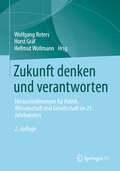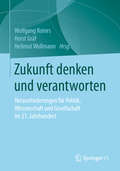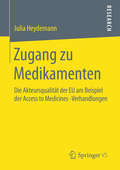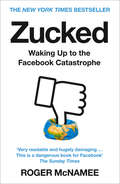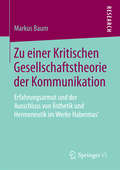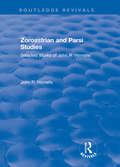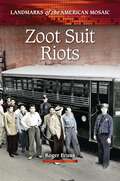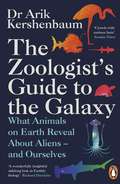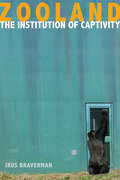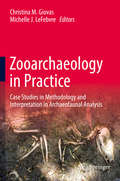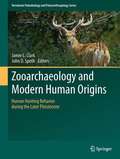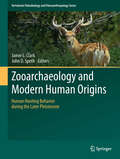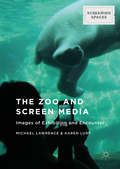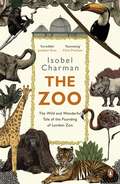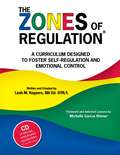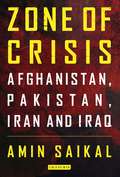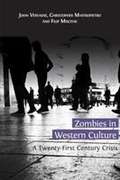- Table View
- List View
Zukunft denken und verantworten: Herausforderungen für Politik, Wissenschaft und Gesellschaft im 21. Jahrhundert
by Wolfgang Roters Horst Gräf Hellmut WollmannDieses Buch untersucht in einem Querschnitt durch aktuelle und künftig zu erwartende Herausforderungen für Politik, Wissenschaft und Gesellschaft (Finanzen, Digitales, Kultur, Stadtentwicklung, Wohnen, Verkehr, Bildung, usw.), ob und unter welchen Bedingungen Staat und Politik in der Lage sind, Zukunft zu denken und – noch wichtiger – zu gestalten. Als Referenzraum und -zeit ziehen zahlreiche Autor*innen die Stadtentwicklungspolitik der 1980er und 1990er Jahre in Nordrhein-Westfalen, vor allem für die Agglomeration Ruhr, heran. In der „Zeitenwende“ wurde der Band vor allem in seiner welt- und europapolitischen Dimension aktualisiert und erweitert.
Zukunft denken und verantworten: Herausforderungen für Politik, Wissenschaft und Gesellschaft im 21. Jahrhundert
Festschrift für Christoph ZöpelDieses Buch untersucht in einem Querschnitt durch aktuelle und künftig zu erwartende Herausforderungen für Politik, Wissenschaft und Gesellschaft (Finanzen, Digitales, Kultur, Stadtentwicklung, Wohnen, Verkehr, Bildung, usw.), ob und unter welchen Bedingungen Staat und Politik in der Lage sind, Zukunft zu denken und – noch wichtiger – zu gestalten.Als Referenzraum und -zeit ziehen zahlreiche Autoren die Stadtentwicklungspolitik der 1980er und 1990er Jahre in Nordrhein-Westfalen, vor allem für die Agglomeration Ruhr, heran.Die HerausgeberDr. Wolfgang Roters war Abteilungsleiter im Ministerium für Stadtentwicklung des Landes Nordrhein-Westfalen, Gründungsvorsitzender der Stiftung Industriedenkmalpflege und Geschichtskultur, Geschäftsführer der Entwicklungsgesellschaft Zollverein und Generalkurator des Museums für Architektur und Ingenieurkunst. Prof. Dr. Horst Gräf ist Rechtsanwalt, war Landesbeamter in verschiedenen Ministerien des Landes Nordrhein Westfalen und Staatssekretär des Ministeriums für Stadtentwicklung, Wohnen und Verkehr in Brandenburg. Prof. Dr. Hellmut Wollmann war Hochschullehrer für Verwaltungswissenschaft an der Humboldt-Universität zu Berlin und ist Gesellschafter des Instituts für Stadtforschung und Strukturpolitik GmbH (IfS), Berlin.
Zugehörigkeiten und Esskultur: Alltagspraxen von remigrierten und verbliebenen Russlanddeutschen in Westsibirien (Ethnografische Perspektiven auf das östliche Europa #6)
by Anna FlackIn der sich zunehmend diversifizierenden deutschen Gesellschaft ist es von besonderer gesellschaftspolitischer Relevanz sich zu vergegenwärtigen, dass Migrierte nicht nur aus Herkunft, Ethnizität oder Religiosität Zugehörigkeit schöpfen. Ebenfalls hat eine Vielzahl von (un-)bewussten Handlungsmustern, Wertvorstellungen und Orientierungen Einfluss auf Kohäsionsprozesse. Anhand von qualitativen Untersuchungen des Ernährungsalltags von remigrierten und nicht ausgesiedelten Russlanddeutschen veranschaulicht Anna Flack, inwiefern Zugehörigkeiten vielschichtig, kontextabhängig und sogar widersprüchlich sind - und liefert damit gleichzeitig spannende Einblicke in die Alltagspraxen dieser von der Forschung bisher eher vernachlässigten Bevölkerungsgruppen.
Zugehörigkeit und Rassismus: Orientierungen von Jugendlichen im Spiegel geographiedidaktischer Überlegungen (Kultur und soziale Praxis)
by Birte SchröderMit Ansätzen des interkulturellen Lernens soll im Geographieunterricht Rassismus entgegengewirkt werden. Der Geographiedidaktik fehlt allerdings bisher eine systematische Auseinandersetzung mit lebensweltlichen Zugehörigkeits- und Rassismuserfahrungen von Lernenden. Birte Schröder füllt diese Lücke und setzt sich in ihrer empirischen Untersuchung mit unterschiedlichen Zugehörigkeitsaushandlungen von Jugendlichen in der Migrationsgesellschaft auseinander. Dabei stehen Brüche, Irritationen und Widerstände im Umgang mit rassismusrelevanten Grenzziehungen und Deutungsmustern im Mittelpunkt. Darauf aufbauend schlägt sie Orientierungslinien für eine rassismuskritische geographische Bildung vor.
Zugang zu Medikamenten: Die Akteursqualität der EU am Beispiel der Access to Medicines -Verhandlungen
by Julia HeydemannIm Zentrum der Studie steht die Untersuchung der EU als Akteur bei multilateralen Verhandlungen am Beispiel des Zugangs zu Medikamenten. Dabei operationalisiert die Autorin den Begriff „Akteursqualität“ umfassend und analysiert ihn erstmalig anhand eines Themas komplexer Interdependenz. Der über vier multilaterale Foren angelegte Vergleich der Access to Medicines-Verhandlungen kommt zu dem Ergebnis, dass die EU dann am erfolgreichsten agiert, wenn die Kommission die Verhandlungskompetenz inne hat, die EU-Mitgliedstaaten sich intern einig sind, verhandlungsrelevante Zwänge fehlen und die EU Vollmitglied im Verhandlungsforum ist.
Zucked: The Education Of An Unlikely Activist
by Roger McNameeThis is the dramatic story of how a noted tech venture capitalist, an early mentor to Mark Zuckerberg and investor in his company, woke up to the serious damage Facebook was doing to our society and set out to try to stop it.
Zu einer Theorie der politischen Identität
by Heinrich BußhoffDie nachfolgenden Erörterungen sind als Versuch aufzufassen, einen Beitrag zur politischen Theorie zu leisten. Dieser Versuch soll eine Mög lichkeit erörtern und damit eine Perspektive für die Politikwissenschaft umrißhaft aufzeigen. Die Problematik ist im Grunde so alt wie die Wis senschaft von der Politik. Es wurde mit Bedacht darauf verzichtet, diesen Versuch im Zusammen hang mit bereits vorhandenen Ansätzen und Entwürfen zur politischen Theorie zu diskutieren, weil einmal der Gewinn für unsere überlegun gen wahrscheinlich als sehr gering angesehen werden muß und weil zum anderen unsere Ausführungen dann notwendigerweise einen Umfang angenommen hätten, der der erklärten Absicht nicht angemessen gewe sen wäre. Die nachfolgenden Erörterungen sind daher nicht als Versuch zur Zusam menfassung auf dem Felde der politischen Theorie anzusehen, sondern als Vorstoß, als eine Art Anregung zur Diskussion. Der vorliegende Versuch ist aus diesem Grunde - wie jeder andere Ver such auch - notwendig unvollkommen und daher leicht angreifbar. Das ist jedoch kein Grund, ihn nicht zu unternehmen. Für Kritik und Hin weise ist der Verfasser dankbar. Inhalt I. Fragestellung und vortheoretische Annahmen . . . . . . . . . . . . 9 II. Theoretische Vorklärungen . . . . . . . . . . . . . . . . . . . . . . . . . . . . 13 1. Begriff der Identität und politische Theorie . . . . . . . . . . . . 13 2. Identität - Identifikation - Prozeß der Identitätsverwi- lichung . . . . . . . . . . . . . . . . . . . . . . . . . . . . . . . . . . . . . . . . . . 20 III. Zur Definition der politischen Identität und Identifikation . , 23 IV. Zum Problem der Identifizierung . . . . . . . . . . . . . . . . . . . . . . 27 V. Zur politischen Identität primärer Tendenz . . . . . . . . . . . . . . 31 VI. Zur politischen Identifikation . . . . . . . . . . . . . . . . . . . . . . . . . . 36 VII. Zur politischen Identität sekundärer Tendenz . . . . . . . . . . . . 39 1. Grundsätzliche überlegungen . . . . . . . . . . . . . . . . . . . . . . . . 39 2. Weiterführende Erörterungen . . . . . . . . . . . . . . . . . . . . . . . 42 VIII. Zum Problem der Korrelation . . . . . . . . . . . . . . . . . . . . . . . . . .
Zu einer Kritischen Gesellschaftstheorie der Kommunikation: Erfahrungsarmut und der Ausschluss von Ästhetik und Hermeneutik im Werke Habermas’
by Markus BaumMarkus Baum widmet sich zweier Begründungs- und Theorieformen: der Kommunikationstheorie Habermas’ und der älteren Kritischen Theorie. Sein Ziel ist es, aufzuzeigen, dass der Anspruch der Theorie des kommunikativen Handelns nur zu erfüllen ist, wenn spezifische Intentionen der älteren Kritischen Theorie in den Rahmen der Theorie Habermas’ überführt werden. Von dieser Diskussion ausgehend werden die Methode der hermeneutischen Interpretation, der Begriff des sozialen Kampfes und der Bereich des Ästhetischen behutsam im Paradigma der Intersubjektivität verortet, sodass sie nicht in Widerspruch zu dessen axiomatischen Annahmen geraten. Die Rückgewinnung der Intentionen der älteren Kritischen Theorie bahnt den Weg zu einer Kritischen Gesellschaftstheorie der Kommunikation.
Zoroastrian and Parsi Studies: Selected Works of John R.Hinnells (Routledge Revivals)
by John R. HinnellsThis title was first published in 2000: This volume collects articles from 30 years of John R. Hinnell's writings. The selection is intended to balance the different areas in which he has worked: the ancient tradition and its influence on Biblical imagery; Parsi history; the living religion; and diaspora communities.
Zoroastrian and Parsi Studies: Selected Works of John R.Hinnells (Routledge Revivals)
by John R. HinnellsThis title was first published in 2000: This volume collects articles from 30 years of John R. Hinnell's writings. The selection is intended to balance the different areas in which he has worked: the ancient tradition and its influence on Biblical imagery; Parsi history; the living religion; and diaspora communities.
Zoot Suit Riots (Landmarks of the American Mosaic)
by Roger BrunsThe Zoot Suit Riots in 1943 and the infamous Sleepy Lagoon murder trial of the preceding year represent a turning point in the cultural identity and historical experience of Mexican Americans in the United States. This engaging study of these regrettable events provides context for understanding the continuing battles in the 21st century over immigration policy and race relations.Although the "zoot suit" had earlier been a black youth fashion trend identified with jazz culture, by the 1940s, the zoot suit was adopted by Mexican American teenagers in wartime Los Angeles, who wore it as their unofficial "uniform" as an act of rebellion and to establish their cultural identity. For a week in June of 1943, the Zoot Suit Riots, instigated by Anglo-American servicemen and condoned by the Los Angeles police, terrorized the Mexican American community. The events were an ugly testament to the climate of racial tension and resentment in Los Angeles—and after similar riots began across the nation, it became apparent how endemic the problem was. This book traces these important historic events and their subsequent cultural and political influences on the Mexican American experience, especially the activist and reform efforts designed to prevent similar future injustices.General readers will gain an understanding of the challenges facing the Mexican American community in wartime Los Angeles, grasp the racial and cultural resistance of the larger Anglo-American society of the time, and see how the blatant injustices of the Sleepy Lagoon trial and the Zoot Suit Riots served to galvanize Latinos and others to fight back. Those conducting in-depth research will appreciate having access to original materials sourced from Federal and state archives as well as newspapers and other repositories of information provided in the book.
Zoot Suit Riots (Landmarks of the American Mosaic)
by Roger BrunsThe Zoot Suit Riots in 1943 and the infamous Sleepy Lagoon murder trial of the preceding year represent a turning point in the cultural identity and historical experience of Mexican Americans in the United States. This engaging study of these regrettable events provides context for understanding the continuing battles in the 21st century over immigration policy and race relations.Although the "zoot suit" had earlier been a black youth fashion trend identified with jazz culture, by the 1940s, the zoot suit was adopted by Mexican American teenagers in wartime Los Angeles, who wore it as their unofficial "uniform" as an act of rebellion and to establish their cultural identity. For a week in June of 1943, the Zoot Suit Riots, instigated by Anglo-American servicemen and condoned by the Los Angeles police, terrorized the Mexican American community. The events were an ugly testament to the climate of racial tension and resentment in Los Angeles—and after similar riots began across the nation, it became apparent how endemic the problem was. This book traces these important historic events and their subsequent cultural and political influences on the Mexican American experience, especially the activist and reform efforts designed to prevent similar future injustices.General readers will gain an understanding of the challenges facing the Mexican American community in wartime Los Angeles, grasp the racial and cultural resistance of the larger Anglo-American society of the time, and see how the blatant injustices of the Sleepy Lagoon trial and the Zoot Suit Riots served to galvanize Latinos and others to fight back. Those conducting in-depth research will appreciate having access to original materials sourced from Federal and state archives as well as newspapers and other repositories of information provided in the book.
The Zoologist's Guide to the Galaxy: What Animals on Earth Reveal about Aliens – and Ourselves
by Arik KershenbaumDISCOVER HOW LIFE REALLY WORKS - ON EARTH AND IN SPACEWe are unprepared for the greatest discovery of modern science - aliens. Scientists are confident that there is life across the universe, yet we have not moved beyond Hollywood stereotypes. The time has come to abandon our fixation on alien monsters and to look at the science.Using his expert understanding of life on Earth and Darwin's theory of evolution Cambridge zoologist Dr Arik Kershenbaum explains what alien life must be like: how these creatures will move, socialise and communicate.Might there be an alien planet with supersonic animals? Will aliens scream with fear, act honestly or have technology? Is the universe swarming with robots? Dr Kershenbaum uses cutting-edge science to paint an entertaining and compelling picture of extra-terrestrial life. These are aliens - but not as you know them.
Zooland: The Institution of Captivity (The Cultural Lives of Law)
by Irus BravermanThis book takes a unique stance on a controversial topic: zoos. Zoos have their ardent supporters and their vocal detractors. And while we all have opinions on what zoos do, few people consider how they do it. Irus Braverman draws on more than seventy interviews conducted with zoo managers and administrators, as well as animal activists, to offer a glimpse into the otherwise unknown complexities of zooland. Zooland begins and ends with the story of Timmy, the oldest male gorilla in North America, to illustrate the dramatic transformations of zoos since the 1970s. Over these decades, modern zoos have transformed themselves from places created largely for entertainment to globally connected institutions that emphasize care through conservation and education. Zoos naturalize their spaces, classify their animals, and produce spectacular experiences for their human visitors. Zoos name, register, track, and allocate their animals in global databases. Zoos both abide by and create laws and industry standards that govern their captive animals. Finally, zoos intensely govern the reproduction of captive animals, carefully calculating the life and death of these animals, deciding which of them will be sustained and which will expire. Zooland takes readers behind the exhibits into the world of zoo animals and their caretakers. And in so doing, it turns its gaze back on us to make surprising interconnections between our understandings of the human and the nonhuman.
Zooarchaeology in Practice: Case Studies in Methodology and Interpretation in Archaeofaunal Analysis
by Christina M. Giovas Michelle J. LeFebvreZooarchaeology in Practice unites depth of treatment with broad topical coverage to advance methodological discussion and development in archaeofaunal analysis. Through case studies, historical accounts, and technical reviews authored by leading figures in the field, the volume examines how zooarchaeological data and interpretation are shaped by its methods of practice and explores the impact of these effects at varying levels of investigation.Contributing authors draw on geographically and taxonomically diverse datasets, providing instructive approaches to problems in traditional and emerging areas of methodological concern. Readers, from specialists to students, will gain an extensive, sophisticated look at important disciplinary issues that are sure to provoke critical reflection on the nature and importance of sound methodology. With implications for how archaeologists reconstruct human behavior and paleoecology, and broader relevance to fields such as paleontology and conservation biology, Zooarchaeology in Practice makes an enduring contribution to the methodological advancement of the discipline.
Zooarchaeology and Modern Human Origins: Human Hunting Behavior During the Later Pleistocene (PDF) (Vertebrate Paleobiology And Paleoanthropology Ser.)
by Jamie L. Clark Editors John D. SpethRecent genetic data showing that Neanderthals interbred with modern humans have made it clear that deeper insight into the behavioral differences between these populations will be critical to understanding the rapid spread of modern humans and the demise of the Neanderthals. This volume, which brings together scholars who have worked with faunal assemblages from Europe, the Near East, and Africa, makes an important contribution to our broader understanding of Neanderthal extinction and modern human origins through its focus on variability in human hunting behavior between 70-25,000 years ago-a critical period in the later evolution of our species.
Zooarchaeology and Modern Human Origins: Human Hunting Behavior during the Later Pleistocene (Vertebrate Paleobiology and Paleoanthropology)
by Jamie L. Clark and John D. SpethRecent genetic data showing that Neanderthals interbred with modern humans have made it clear that deeper insight into the behavioral differences between these populations will be critical to understanding the rapid spread of modern humans and the demise of the Neanderthals. This volume, which brings together scholars who have worked with faunal assemblages from Europe, the Near East, and Africa, makes an important contribution to our broader understanding of Neanderthal extinction and modern human origins through its focus on variability in human hunting behavior between 70-25,000 years ago—a critical period in the later evolution of our species.
The Zoo and Screen Media: Images of Exhibition and Encounter (Screening Spaces)
by Michael Lawrence Karen LuryThis book is the first critical anthology to examine the controversial history of the zoo by focusing on its close relationship with screen media histories and technologies. Individual chapters address the representation of zoological spaces in classical and contemporary Hollywood cinema, documentary and animation, amateur and avant-garde film, popular television and online media. The Zoo and Screen Media: Images of Exhibition and Encounter provides a new map of twentieth-century human-animal relations by exploring how the zoo, that modern apparatus for presenting living animals to human audiences, has itself been represented across a diverse range of moving image media.
The Zoo: The Wild and Wonderful Tale of the Founding of London Zoo
by Isobel CharmanHow one man's mad mission became one of the best-loved places in the worldThe creation of a zoo in Dickensian London - when only one other existed across the world - is a story of jaw-dropping audacity. It is the story of trailblazing scientists, rival zookeepers and aristocratic naturalists collecting amazing animals from all four corners of the globe.It is the story of a weird and wonderful oasis in the heart of a swirling city, and of incredible characters, both human and animal - from Stamford Raffles and Charles Darwin to Jenny the orang-utan and Obaysch the celebrity hippo, the first that anyone in Britain had ever seen.Against a background of global Empire, domestic reform and industrialisation, this is a new history of a new world.
The Zones Of Regulation (PDF): A Cirriculum To Foster Self-regulation
by Leah Kuypers Michelle Garcia WinnerThe Zones of Regulation is a curriculum geared toward helping students gain skills in consciously regulating their actions, which in turn leads to increased control and problem solving abilities. Using a cognitive behaviour approach, the curriculum’s learning activities are designed to help students recognise when they are in different states called “zones,” with each of four zones represented by a different colour. In the activities, students also learn how to use strategies or tools to stay in a zone or move from one to another. Students explore calming techniques, cognitive strategies, and sensory supports so they will have a toolbox of methods to use to move between zones. To deepen students’ understanding of how to self-regulate, the lessons set out to teach students these skills: how to read others’ facial expressions and recognise a broader range of emotions, perspective about how others see and react to their behaviour, insight into events that trigger their less regulated states, and when and how to use tools and problem solving skills. The curriculum’s learning activities are presented in 18 lessons. To reinforce the concepts being taught, each lesson includes probing questions to discuss and instructions for one or more learning activities. Many lessons offer extension activities and ways to adapt the activity for individual student needs. The curriculum also includes worksheets, other handouts, and visuals to display and share. These can be photocopied from this book or printed from the accompanying USB.
Zones of Conflict in Africa: Theories and Cases
by George Klay Kieh Ida Rousseau MukengeTorn by ongoing civil and military violence, Africa presents a challenge to scholars interested in the root causes of conflict. Each conflict is unique, but overall they exhibit common patterns. The contributors of this book employ an eclectic array of current explanations of civil strife and how to resolve it. The first half of the book provides the relevant theoretical background. Theories of conflict and conflict resolution, the larger context of African strife in Africa, and patterns and trends of conflict are discussed. Shifting from the general to the particular, the remaining chapters of this volume gauge the accuracy and usefulness of the current thinking on conflicts by grounding it in case studies drawn from the Great Lakes Region, Liberia, Nigeria, and Zambia.
Zone of Crisis: Afghanistan, Pakistan, Iran and Iraq
by Amin SaikalThe West Asian states of Afghanistan, Pakistan, Iraq and Iran have over the last few decades represented an arc of crisis. Characterised by fractured and dysfunctional political elites, fraught economic policies, and ideological struggles between the forces of authoritarianism and democratisation, neo-fundamentalism and pluralism, they embody a mosaic of ethnicities. Amin Saikal, a distinguished Afghan-born scholar of international affairs, provides a sweeping new understanding of the complex contemporary political and social instability encompassing the region. Critically comparing democratisation and counter-insurgency efforts in Afghanistan, Iraq and Pakistan, and examining both recent Western intervention and the history of foreign influence in the region, Saikal looks at how US entanglement has affected Pakistani and Iranian domestic politics and foreign affairs. How has this influenced the success or failure of the occupation in Afghanistan and Iraq? What solutions can be taken to ensure regional security? An informed and balanced overview on a troubled region, this book will fascinate general readers and prove essential reading for specialists.
Zombies in Western Culture: A Twenty-First Century Crisis (PDF)
by John Vervaeke Christopher Mastropietro Filip MiscevicWhy has the zombie become such a pervasive figure in twenty-first-century popular culture? John Vervaeke, Christopher Mastropietro and Filip Miscevic seek to answer this question by arguing that particular aspects of the zombie, common to a variety of media forms, reflect a crisis in modern Western culture. The authors examine the essential features of the zombie, including mindlessness, ugliness and homelessness, and argue that these reflect the outlook of the contemporary West and its attendant zeitgeists of anxiety, alienation, disconnection and disenfranchisement. They trace the relationship between zombies and the theme of secular apocalypse, demonstrating that the zombie draws its power from being a perversion of the Christian mythos of death and resurrection. Symbolic of a lost Christian worldview, the zombie represents a world that can no longer explain itself, nor provide us with instructions for how to live within it. The concept of 'domicide' or the destruction of home is developed to describe the modern crisis of meaning that the zombie both represents and reflects. This is illustrated using case studies including the relocation of the Anishinaabe of the Grassy Narrows First Nation, and the upheaval of population displacement in the Hellenistic period. Finally, the authors invoke and reformulate symbols of the four horseman of the apocalypse as rhetorical analogues to frame those aspects of contemporary collapse that elucidate the horror of the zombie. Zombies in Western Culture: A Twenty-First Century Crisis is required reading for anyone interested in the phenomenon of zombies in contemporary culture. It will also be of interest to an interdisciplinary audience including students and scholars of culture studies, semiotics, philosophy, religious studies, eschatology, anthropology, Jungian studies, and sociology.
Zombies in Western Culture: A Twenty-first Century Crisis
by John Vervaeke Christopher Mastropietro Filip MiscevicWhy has the zombie become such a pervasive figure in twenty-first-century popular culture? John Vervaeke, Christopher Mastropietro and Filip Miscevic seek to answer this question by arguing that particular aspects of the zombie, common to a variety of media forms, a crisis in modern Western culture. The authors examine the essential features of the zombie, including mindlessness, ugliness and homelessness, and argue that these reflect the outlook of the contemporary West and its attendant zeitgeists of anxiety, alienation, disconnection and disenfranchisement. They trace the relationship between zombies and the theme of secular apocalypse, demonstrating that the zombie draws its power from being a perversion of the Christian mythos of death and resurrection. Symbolic of a lost Christian worldview, the zombie represents a world that can no longer explain itself, nor provide us with instructions for how to live within it. The concept of 'domicide' or the destruction of home is developed to describe the modern crisis of meaning that the zombie both represents and reflects. This is illustrated using case studies including the relocation of the Anishinaabe of the Grassy Narrows First Nation, and the upheaval of population displacement in the Hellenistic period. Finally, the authors invoke and reformulate symbols of the four horseman of the apocalypse as rhetorical analogues to frame those aspects of contemporary collapse that elucidate the horror of the zombie. Zombies in Western Culture: A Twenty-First Century Crisis is required reading for anyone interested in the phenomenon of zombies in contemporary culture. It will also be of interest to an interdisciplinary audience including students and scholars of culture studies, semiotics, philosophy, religious studies, eschatology, anthropology, Jungian studies, and sociology.
Zombies in der Kirche: Das Zombie-Motiv als Allegorie der Säkularisierung in The Walking Dead und Fear the Walking Dead (Film)
by Daniel HercenbergerDas Kontrastpaar »Zombies und Kirche« schlägt sich teils prominent in der Popkultur nieder: Quality TV-Formate wie The Walking Dead inszenieren die titelgebenden Untoten in christlich-religiösen Kontexten. Daniel Hercenberger nimmt eine theologische Filmanalyse der US-amerikanischen Serien The Walking Dead und Fear the Walking Dead vor und zeigt anhand exemplarischer Szenen und Figuren, wie postmortale Existenzen Säkularisierungsprozesse versinnbildlichen. Die kulturhistorische Betrachtung des figuralen Motivs macht deutlich, dass sich die Figur des Zombies im Besonderen für eine derartige Allegorisierung eignet.
